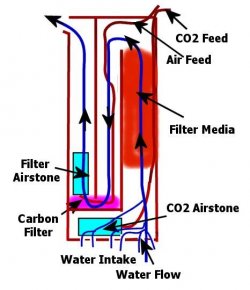timg
New Member
Is it right that they don't mix? If so, can I run my air filters on pure CO2?
I want to convert all my tanks to real plants, mainly to combat the nitrates, but also because they look so much better. The main concern is that every time I introduce plants to the tanks, within a couple of weeks they start to go yellow and then look worse than their plastic counterparts. Sooner or later they just die off.
I've tried the liquid fertilizers, and all they did was to create larger yellow plants, that died off quicker! Lighting is quite sufficient, water parameters are fine, except for the nitrates, which tend to be a little on the high side, (20 - 40), hence the wish for plants, so the only thing left is the co2 level in the water. Weekly water changes control the nitrate levels, and the plecs cope with the algae, but it's getting to be a bind having to do the changes all the time on all the tanks.
If using air pumps, do I need co2 for the plants, or should there be enough going into the water already through the air?
I have been experimenting today, and it seems possible to increase the concentration of co2 in the air by putting a generator inline, but is it needed? Will an excess of co2 cause any problems within the tank environment? How will it affect the PH for example?
My local petstore knows nothing about this subject, and although I have found a lot of info on the subject, no-one has linked the two things together. Has anyone got any experience in this, or knowledge about the subject?
Any thoughts folks?
I want to convert all my tanks to real plants, mainly to combat the nitrates, but also because they look so much better. The main concern is that every time I introduce plants to the tanks, within a couple of weeks they start to go yellow and then look worse than their plastic counterparts. Sooner or later they just die off.
I've tried the liquid fertilizers, and all they did was to create larger yellow plants, that died off quicker! Lighting is quite sufficient, water parameters are fine, except for the nitrates, which tend to be a little on the high side, (20 - 40), hence the wish for plants, so the only thing left is the co2 level in the water. Weekly water changes control the nitrate levels, and the plecs cope with the algae, but it's getting to be a bind having to do the changes all the time on all the tanks.
If using air pumps, do I need co2 for the plants, or should there be enough going into the water already through the air?
I have been experimenting today, and it seems possible to increase the concentration of co2 in the air by putting a generator inline, but is it needed? Will an excess of co2 cause any problems within the tank environment? How will it affect the PH for example?
My local petstore knows nothing about this subject, and although I have found a lot of info on the subject, no-one has linked the two things together. Has anyone got any experience in this, or knowledge about the subject?
Any thoughts folks?



 /www.aquaessentials.co.uk/index.php?...roducts_id=1236
/www.aquaessentials.co.uk/index.php?...roducts_id=1236